CategoryTony's Testimonials Archives - Audio Visual Bend Blog
June 8th, 2021
What AV systems can be hidden away.
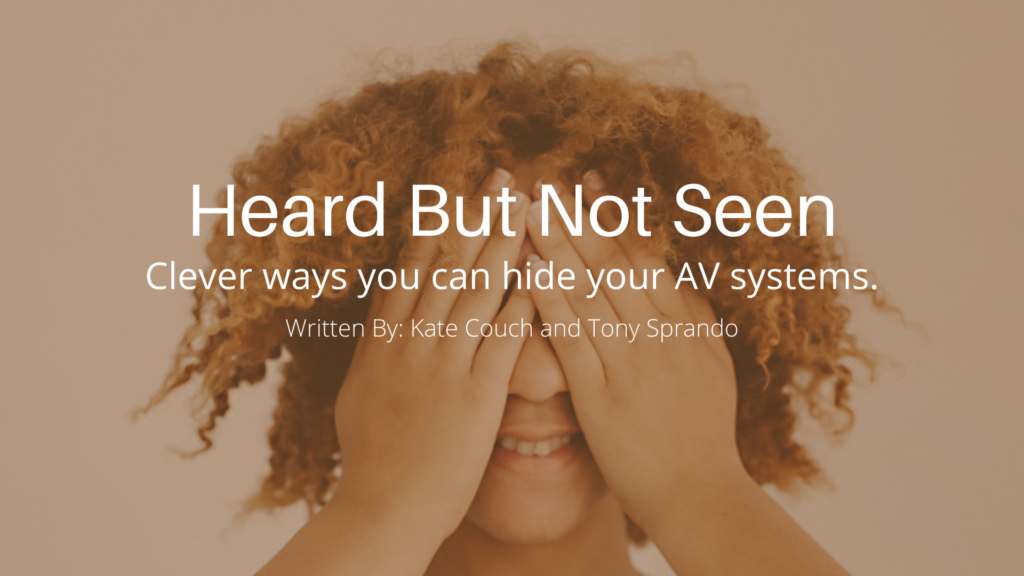
Photo and Graphics by: Kate Couch with Canva
Written By: Kate Couch and Tony Sprando
Design over function is often an argued topic amongst the design community. We think that these things are in lieu of the other. That isn’t always the case. In many circumstances, the ability to get maximum function and purpose out of a system can in tandem blend in seamlessly with the design. Design with functionality is becoming more popular in the 21st century. With people living in less and less space, we need to maximize our design pieces so they can serve as both. Be that storage, organization, or just having a second purpose. This can go into the corporate office as well. It’s important to be able to maximize space when you don’t have that much and this is very plausible in most corporate workspaces. There’s also a lot of corporate workspaces that might need an AV system but the design is very important to their business. Any sort of waiting room or conference room that needs to look sleek and professional and represent the company can not have a bunch of wires and AV odds and ends sitting on a three-legged table in the corner. Visible AV systems aren’t always the most attractive option. So what is?
This is where AV systems are heard and not seen. There are certain things that you can install to make your AV systems tucked away or have them seamlessly blend in with your design. The first and most easy way to hide an AV system is to have it in a nearby closet. Having sort of a command center for your AV rack is an easy way to make your AV system accessible and keep it protected while it also being out of sight. But if you’re crunched on space there are other things you can do.
There are a couple of ideas when it comes to hiding audiovisual systems. It depends on what you have installed but for the most part, you can get low-profile speakers and microphones installed on the ceilings. People are less likely to look up so they’re out of the way while still serving their purpose.
When it comes to managing wires there is the molding that you can get that can be installed on the corners of a space. This molding similar to a baseboard can go vertically or horizontally on the ceilings, floor, or in between two walls. Inside the molding is a space for wires. This is an easy way to hide wires when you’re installing an audio-visual system after a house or office has been built. It’s important to keep in mind that you do want your AV system to be accessible for easy maintenance though. Make sure that just because you might not be able to see it that doesn’t mean you can’t get to it.
There are also lots of design pieces that are secretly AV systems. TVs that look like framed pictures have become very popular in recent years. AV has been easier to hide in furniture pieces. This can be numerous amount of things, couches, tv consoles, desks, and pictures on walls can all hold and hide cameras, wires, and other AV corporate or home needs.
The last option would be to have an AV system that is only displayed when in use. For example, having a remote control system where your tv retracts from a picture frame on the wall. Or a projector or camera comes out of the ceiling. Though this is a slightly more expensive option this is the most streamlined and user-friendly. It is also easier to implement than many believe. Putting equipment on retractable tracks has become popular and is more accessible.
Keep all these things in mind when trying to implement new AV equipment and systems in your home or corporate office and make sure to ask your local AV company like AV Bend if these are possible for your project!
*This article is Tony Sprando of AV Bends intellectual property. To use or reference this article please contact: Tony@avbend.com*
To know more about Tony and his professional profile see these:
To know more about Kate and her professional profile see these:
June 1st, 2021

Photo By: Kate Couch with Canva
Written by: Tony Sprando and Kate Couch
“Never separate the life you live from the words you speak” – Paul Wellstone
We live in a he-said-she-said society. We interact through voice memos and quick videos focussing on what is said and not what is done. The art of holding to your word has seemed to have lost its value. But unlike a lot of change we’ve seen recently this is something that shouldn’t go. Sticking to your word and having a job well done better than an idea well said is a value I hope to see stick around in our society. When it comes to business, especially in the AV business, it’s important to be able to live up to the truth you speak.
We see it all the time in pop culture or even in our government. Politicians will make empty promises, celebrities will say they stand for one thing but their actions will do the opposite chasing a paycheck or cash out. It’s no secret we live in a fallen money-driven society. I know there’s not much we can do about that particular topic there is a lot we can do on our end about following through with our word. It is much better to be somebody that has validity behind their words. The old saying actions speak louder than words needs to make a comeback. it seems as though through years of media and mixing up truths and common goals we have put this idea about how our actions speak about us to bed.
Never separating the life you live from the words you speak can play into both professional and personal areas of our lives. In one very obvious way when we go out to give a bid we don’t like to make empty promises to people or go back on our word. I’m not going to tell a client that I can do something that’s not realistic or intentionally give them numbers that aren’t true. This is just good business. Nobody likes to be told one thing and then to have another done to them. There are ways that we unintentionally separate our actions from our words in business. This can be avoided when you’re talking with the client trying to understand their vision while making sure to also tell them realistic things about it. Making sure clients understand that AV workers are not miracle workers. Though you want to hear out their vision and solve their problems not everything is going to be possible, and not everything they want fits in their budget (like we talked about in last week’s article.)
It can be easy to want to make empty promises to clients unintentionally. You want to be able to give people what they want and sell the products that you want to sell. It’s important to remember the integrity of your business is in a direct parallel with the validity of your words. Making sure that you don’t just talk the talk but you can walk the walk. With the way that society treats the importance and value of your actions having a business that does what they say and has a good reputation because of its verbal integrity will make your business stand out compared to ones that don’t.
It’s also important to remember that your business and professional life is also a reflection of your personal life. It’s common knowledge to have some separation from your personal and professional life I know this is true it’s important to remember that when you’re treating co-workers or employees badly it’s easy to take that into your home and treat your children or spouse poorly as a result. This can go vice versa. This is why from a personal and professional standpoint it’s generally a good saying not to separate the life you live from the words you speak. Following through on your commitments, listening to what others say, and stop agreeing with people just to agree with people are all goals we should be making in 2021.
Make sure to follow along for more business tips, AV advice, and personal testimonies from AV Bend.
*This article is Tony Sprando of AV Bends intellectual property. To use or reference this article please contact: Tony@avbend.com*
To know more about Tony and his professional profile see these:
To know more about Kate and her professional profile see these:
May 25th, 2021

Photo By: Kate Couch with Canva
There never are enough hours in the day, how can we maximize our time when time won’t wait for us?
Written By: Kate Couch and Tony Sprando
Time management is something we start learning as early as 6 and really never stop learning. It’s something that goes into every area of your life. If you have bad time management in the morning you’ll be late to work. If you have poor time management at work you’ll be late for dinner or you might not get assignments done on time. In school, if you had poor time management you have bad grades. If you have poor time management in the kitchen you’ll have burnt or cold food. Time management truly does affect every single aspect of our life if you really sit down and think about it. Time management is crucial in business and there’s been a lot of time management trends throughout the years. The newest time management trend is called timeboxing.
Timeboxing is a modern theory of time management. Benjamin Franklin wrote over 260 years ago “you may delay but time will not.” His idea still stands true today. There really never are enough hours in the day. I frequently find myself saying “whelp im going to have to push that till tomorrow” or “if I just had another hour.” I, unfortunately, struggle with time management all the…time (no pun intended.) Typical time management oftentimes looks like a to-do list. Walk the dog, write a presentation, send out emails, make phone calls, etc. We accomplish this to-do list by starting on a task and working on it until it’s finished. Timeboxing is actually sort of the opposite. When you make a timeboxing management schedule you schedule a certain time for things but once that time is up you stop doing that task. This means that especially in the beginning you won’t finish all of the tasks. Some things are straightforward, you walk the dog for 30 minutes, but others you may not have enough time for like, working on a presentation for only an hour.
This may seem like a problem at the beginning but the idea is that when you block off a certain scheduled amount of time for tasks your productivity will then learn to meet that time requirement. This helps eliminate distractions and increase your productivity. Maybe checking emails takes you an hour to two hours usually. You might find yourself getting distracted or having to reread emails over and over again. But when you only have 30 minutes to check and respond to emails it becomes something that needs to be done now. Your brain will go into hyper-focus, getting the task done hopefully before the time is up. It’s definitely a learning curve in the beginning and you probably won’t be able to finish tasks in the time that you give yourself. But the goal is the more consistent you are with timeboxing the more you will be able to meet your time limits.
Most professionals recommend having time boxes of 25 to 30 minutes. Timeboxing has become increasingly popular over the last decade and is even used by famous businessman Elon Musk. Elon Musk encourages 5-minute time boxing. He tries to block off every 5 minutes of his day. Scheduling every little thing with the minimum amount of time it takes to do it. This means that he genuinely makes the most out of every day. It’s not meant for everybody but a little bit of timeboxing in our lives, especially, with things that have stricter deadlines or with activities that you might like to be more productive with can make a big improvement in your personal and professional life. Timeboxing encourages increased productivity but also discourages distractions. It makes buckling down and getting the job done a lot easier. If you make time boxing part of your daily schedule it might also feel less overwhelming to fit excess things into your schedule.
Timeboxing is definitely an interesting way of time management. But it’s heavily encouraged by businessmen and professionals and it’s something you should consider trying.
*This article is Tony Sprando of AV Bends intellectual property. To use or reference this article please contact: Tony@avbend.com*
To know more about Tony and his professional profile see these:
To know more about Kate and her professional profile see these:
May 18th, 2021

Photo by: Kate Couch with Canva
Written By: Tony Sprando and Kate Couch
What we believe and what we feel about a situation has strong ties. This usually circulates around the value we put on something. Like when you reach for that apple in the grocery store, you hesitate and hover for a moment to grab the one that looks the best… without knowing where it was grown, what care was taken to get it there, and how it was carefully or handled by the grocery clerk. You are putting a certain amount of trust in that purchase, oftentimes based on how you were treated at the door. You buy based on what you need, price, influencing of marketing and item placement, and personal assessment of the item. When you think about it we put a lot of thought into these things subconsciously.
When it comes to something much more expensive, there is a higher level of feeling and assumption involved… or not. Over the past 20 years, I’ve done many audiovisual jobs. But for as many jobs I’ve done I’ve also calculated twice as many bids. end as somebody who works delivering a service you notice a pattern when giving a bid. You will find that when you go out and you assess what client needs, finding them the right services for a fair price, for some people it’s never enough. Oftentimes no matter how much you try to give some a deal, or explain why something is costly they will not think it is cheap enough.
Where customers “fall down” starts as a client drilling the service provider to get the price down possibly to please a boss or to make them feel better about the service. Another example is leaning into friends, family, or a church friend for a deal. We might do this because “in the name of making an eternal difference” may guilt them into giving you a good deal, or believing that God demands we are “frugal” and we can’t have nice things because “the humble will inherit the earth” … a bible verse that is so often taken out of context.
Lastly, we can go wrong by blindly going with the lowest bid and trusting the provider that they know what they are doing, this would be coined as the belief in poverty theology. This is a trap many frugal people fall into. Unfortunately doing something cheap isn’t always doing something right. When you go with the cheapest option then find out that it’s not working properly after. I find that they patch the problems with their audiovisual system and suffer through it until… eventually calling out for help to rescue them from a subpar system installation. Unfortunately at this point, the price tag is usually much higher. It’s a well-known fact that it is easier to build something new than try to salvage or demo an existing audiovisual system.
In all my years of AV, I have seen a much higher success rate in investing in people and not worrying as much about the money. Set the profit you need to run a business, then stand tall as you hand over the bid or proposal… and if the customer does his or her due diligence then they will find an Audiovisual integrator that is highly spoken of and then just spends the money once. Though your job may cost a bit more than you may have thought, your actions will give the AV group confidence that they are not being squeezed. This will allow them to work freely, giving you a quality system you can stand up to with confidence.
All that being said this doesn’t mean a job can’t be cost-efficient. We always want to work with our clients to find a cost-efficient solution for them that gets their goals completed and that will last. Quality over quantity, vice-versa, is an age-old debate and each one has its time and place. But I will settle it for AV, when you build a quality AV system using a reliable service provider, you will be happy with results that will stand the test of time and meet your needs: the first time.
*This article is Tony Sprando of AV Bends intellectual property. To use or reference this article please contact: Tony@avbend.com*
To know more about Tony and his professional profile see these:
https://www.linkedin.com/in/tonysprando/
https://www.ravepubs.com/author/tsprando/
www.tonythevguy.com
To know more about Kate and her professional profile see these:
https://www.linkedin.com/in/kate-couch-a7318220a/
https://k8couch.wixsite.com/katecouch
May 11th, 2021
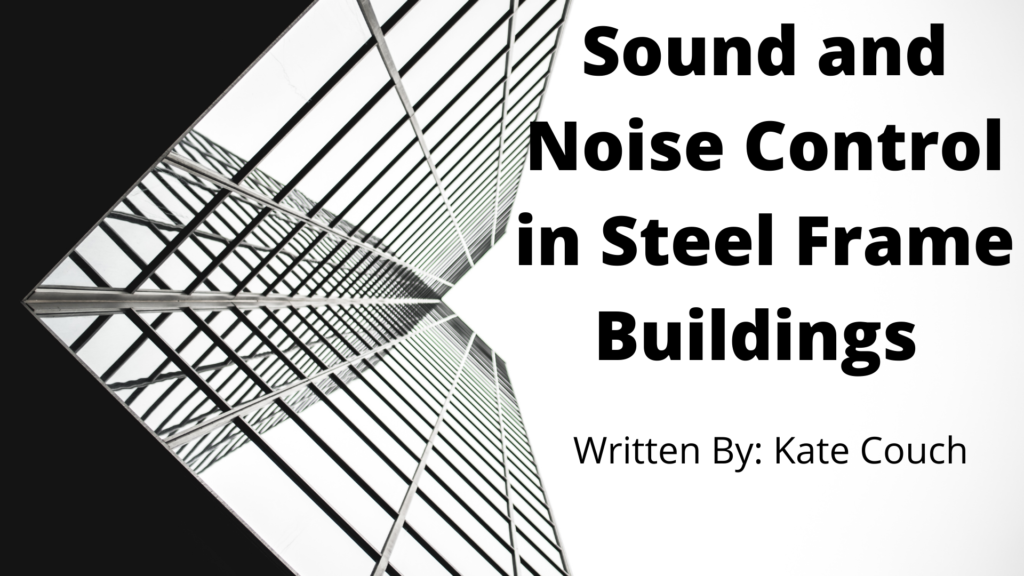
Photo and graphics by Kate Couch with Canva
Written By: Kate Couch with inspiration from American Institute of Steel construction’s article: Sound and Noise Control in Steel Frame Buildings.
At AV Bend we deal with a lot of commercial customers. People trying to design sound solutions for their commercial space. But one thing in AV that frequently flies under the radar is sound isolation in steel-frame and metal buildings. With more corporate offices being built similar to homes the industrial-type buildings are left by the wayside. But they still exist and lots of them still need proper acoustical treatment. So that poses the question: how do you treat a mental space? Ironically enough that question isn’t just for Audio Visual. Owner of AV Bend Tony Sprando has a son who owns a 1981 VW Rabbit, which until the other day was extremely loud. After some thought, they decided to line the interior with, Dynamat 11102 Dynaliner a thick self-adhesive sound deadener. This reduced the noise of the car by over 50% and was a simple and cheap fix for the sound metal problem. The fact that metal is such a loud material realy can affect multiple different areas.
Sound and noise control with metal and steel frame buildings begins in architecture. When an architect is designing these buildings (which frequently are schools warehouses and studios) they take certain design styles into account when using these materials. Taking the principle of acoustic comfort, which is what materials a designer uses, they will combine the louder more reflective materials such as metal with more sound-absorbent ones like wood. The sound absorbency of a material is referred to as its sound transmission class. This reduces how much sound is bouncing off of the walls. In some cases, something called flanking transmission happens when sound travels through walls and ceilings. So in addition to adding more of those materials that absorb sound, they also tend to make thicker walls with heavier-set insulation which decreases the sound travel or flanking transmission from room to room. Stud size and spacing, as well as the thickness of the walls, will all determine how much sound blockage and absorption there is. The more layers in a wall the less sound travel.
How sound travels is a science and this is something that architects also have to keep in mind. In addition to what materials they use and how much materials they use, how they placed these materials in the design of the building will also heavily affect sound travel. Architects that are dealing with louder materials like metal will frequently design a more acoustically quiet architectural design. Placing walls and ceilings strategically so the sound travels in a quieter way. But in order to completely do an architectural acoustical treatment, you need to take both materials and design into account. For example, how you place the walls and ceilings can dampen the sound of traveling voices but not hard sole shoes on tile metal or wood floors. Shoes can really drive up the decibel count of space. This is called Impact Insulation Class or IIC. This is why it’s important to also consider the materials used. Adding things like carpet the hallways that may need to be quieter.
After the architect designs a building with noise control and acoustical treatment in mind then a company like AV Bend comes in. This is when the decoration design and additional things we can add to the building come in hand. If things like wall thickness and materials didn’t do the job we can then take our acoustical treatment plans that we use for other commercial spaces into metal frame buildings. We also consider what is happening in the room. Taking into account the frequency of those sounds to design something custom. Adding foam wall panels considering certain types of furniture and its placement. All the way down to what is hung on the walls and where a local AV company we’ll take the design of the building and treat it for its specific noise issues.
If you have a metal-framed building for your corporate office consider using a local company like AV Bend to treat your sound issues.
*This article is Tony Sprando of AV Bends intellectual property. To use or reference this article please contact: Tony@avbend.com*
To know more about Tony and his professional profile see these:
https://www.linkedin.com/in/tonysprando/
https://www.ravepubs.com/author/tsprando/
www.tonythevguy.com
To know more about Kate and her professional profile see these:
https://www.linkedin.com/in/kate-couch-a7318220a/
https://k8couch.wixsite.com/katecouch
May 4th, 2021

What is a digital marketing and how to take advantage of it?
Written By: Kate Couch
Digital marketing is a form of online marketing, it usually circulates video and virtual marketing such as video advertisements or video placement on websites. It can also refer to virtual advertisements, gifs, and other animations. Digital marketing in the world of IOT and technology is very prevalent for businesses. In audiovisual we work to present digital marketing for clients and cater to clients who need screens and audio for digital marketing. But as a business, it’s also important to note that digital marketing is something that every business should consider integrating.
There are four main types of digital marketing, pencil drawing animation, character animations, graphic animations, avatar animations. These are all displayed across the internet and other forms of virtual marketing. A lot of these are achieved through apps like Adobe Photoshop, Canva, Procreate, and more. It is graphic design geared towards marketing and oftentimes animated graphic design. But digital marketing can also be purely video and live actors as well. Digital marketing as a whole means how you can mark your product or service using the internet. How can you sell a product using audio-visual? With everyone using the internet 24/7 it’s an easy question. The hard one is: where and how?
One of the main helpers of digital marketing and SEO is Google. Which has a lot of digital marketing plans. The nice thing about the internet of things (IOT) which we talked about in our last article is that it’s all about collecting data. With this data, you can see your customer bases and get their analytics. See what your customers need and what they’re using. You could use this in any form of audio-visual or small business. With this information, you can go even deeper into digital marketing. Once you understand what you need to mark it and who to, is developing digital advertising.
With graphics design apps like Adobe or Canva, you can create ads. If you want to display video digital marketing you could use apps such as Vidivy, Lumen5, or Avairy which helps aid video marketing. You can then use local audiovisual companies (like AV Bend) help to display your video marketing or even help you create it.
It’s important with digital marketing to develop a goal. After you identify what your customers need you can then identify what form of digital marketing you would like to use to reach these customers and why you want to reach them. Then you can come up with an action plan of how you’re going to reach them and what things you are going to do to reach them. It’s also important to identify why you are reaching these people. By using the data from IOT and other analytics like Google you can identify why you are doing this type of marketing to avoid wasting time or money.
The most general form of digital marketing is Media. Media has is been an up-and-coming job title in recent years. Because we are always on our phones media and marketing through media can play a really huge role in your business. Making sure you’re connected to popular social media sites like LinkedIn, Facebook, Instagram, Youtube, Twitter, and Reddit. Will help you market to a younger generation and keep your business streamlined for the future. Below are a few tips that you can follow to help keep up on social media.
- Assign somebody from your team to take photos of projects before and after
- Post frequently frequency reminds customers that you’re around and that you have good communication
- Join groups on social media to stay connected with people that are interested in areas of your business
- Keep it clean and consistent. Consistency is important with social media to properly display your business format. Keep it clean by being picky with where you post making sure it’s only on relevant sites.
- Make sure to invest locally. You can do this through local papers or websites or blogs. When you establish your business as part of the community You build loyalty among it. Integrating locally is extremely important.
Digital marketing is going to become the only form of marketing in the future so the sooner you understand it and start to integrate it into your company the easier the transition will be. These last few years have been very technology-heavy, and the technological advancements that have been made even in the last year are insane. It’s important as a business owner and of clients of audio-visual to understand these changes and hop on the trends so our technology doesn’t start to run us; we run it.
*This article is Tony Sprando of AV Bends intellectual property. To use or reference this article please contact: Tony@avbend.com*
To know more about Tony and his professional profile see these:
https://www.linkedin.com/in/tonysprando/
https://www.ravepubs.com/author/tsprando/
www.tonythevguy.com
To know more about Kate and her professional profile see these:
https://www.linkedin.com/in/kate-couch-a7318220a/
https://k8couch.wixsite.com/katecouch
April 28th, 2021
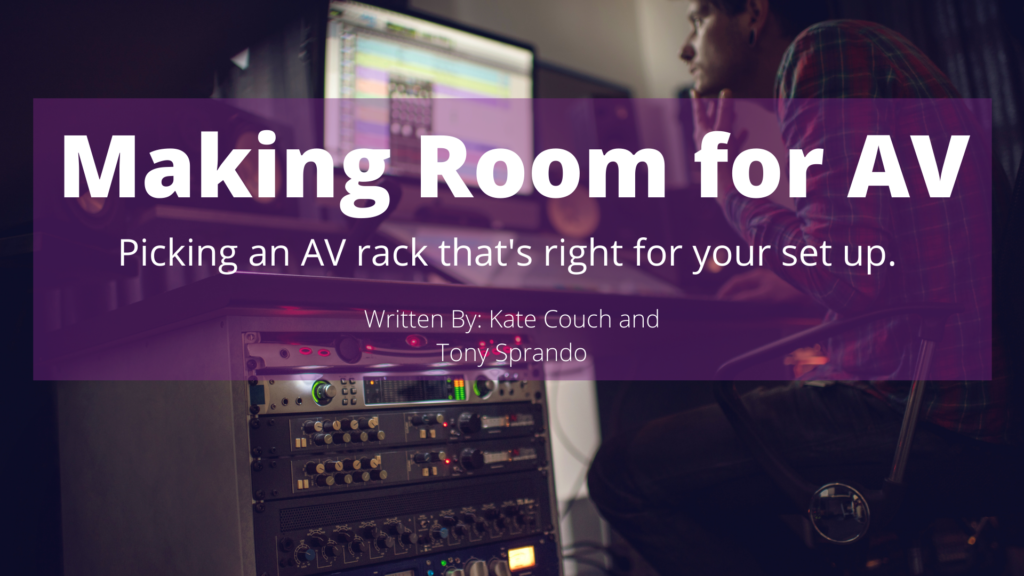
Photo and Graphic Design By: Kate Couch with Canva
Picking an AV rack that’s right for your setup.
Written By: Kate Couch and Tony Sprando
In past articles, we’ve mentioned how AV can be an eyesore or a design statement. This flows into lots of areas AV. Something that’s become more popular in recent years is cable design or cable management. With technology becoming more and more popular in more aspects of the workplace and in your home, cables tend to clutter up a space. The same goes with audiovisual cables, equipment, and behind-the-scenes stuff that keeps things running. There’s a solution to this called an AV rack. An audio-visual rack is basically a storage shelf designed to hold audio-visual equipment and manage cables. They make some really cool ones that have interesting designs and they make the less cool metal ones you might see in a closet behind the desk. Choosing the right AV rack is important so your AV setup in-home or in your company can last you several years and be easily accessible for maintenance. But how do you choose the right one?
Deciding where you’re going to place your AV rack and how big is going to be is the first step. If you choose an AV rack that’s too large your equipment might not fit properly in it making it harder for you to use and harder for other people to use and service. In addition to this, if your AV rack is put in an area of your home or office that’s hard to reach or frequently cluttered with things, you pose the same problem as before. It’s good to talk to the person who’s installing your audio-visual system and ask them what size AV rack they think you need. It’s good for the client to plan out a good area of your commercial space or home that is easily accessible, not frequently cluttered, but also is in a good spot for the AV setup itself. Taking these things into an account will set you on the right track for getting the right system.
Some other things to consider in addition to size and space are RU count, which is the “rack unit count” that is in the same category as sizing and your local AV professional can help with this.
Make sure to take into consideration what your plans for a space and for the AV in the building are for the future. Planning ahead of time can save you money in the long run since you’ll be avoiding having to redo everything to fit your new needs.
Did you include Storage? People frequently forget to add storage onto their AV racks. Whether it’s for additional cables, remotes, batteries, wires, tools, etc it’s more important than you know. Whatever you might need to store with your other audiovisual equipment can frequently slip the mind and when you’re done with the setup and you have nowhere to put these things so you’re screwed.
Equipment BTU is also an important one that can easily slip the mind. Equipment BTU is the measure of how much of the heat produced by the equipment makes it into your home. This is important to consider when placing your av rack. Making sure you have proper ventilation and airflow to prevent overheating and short-circuiting. In addition, consider the network infrastructure.
You want to keep in mind when choosing a design of a rack how it’s used. Where is the access, (front, rear, sides, depth) how will that fit in your space? Where is the power access and how easy is it to manage. Do you need it to swivel or be a pull system.? Is it better if it’s fixed to a wall?
If you consider all these things you should be good for a long-lasting easily accessible AV rack and set up in your commercial space or home. Make sure to reach out to your local AV company (like AV Bend) for installation rates and for more information on AV storage and racks.
*This article is Tony Sprando of AV Bends intellectual property. To use or reference this article please contact: Tony@avbend.com*
To know more about Tony and his professional profile see these:
To know more about Kate and her professional profile see these:
April 20th, 2021
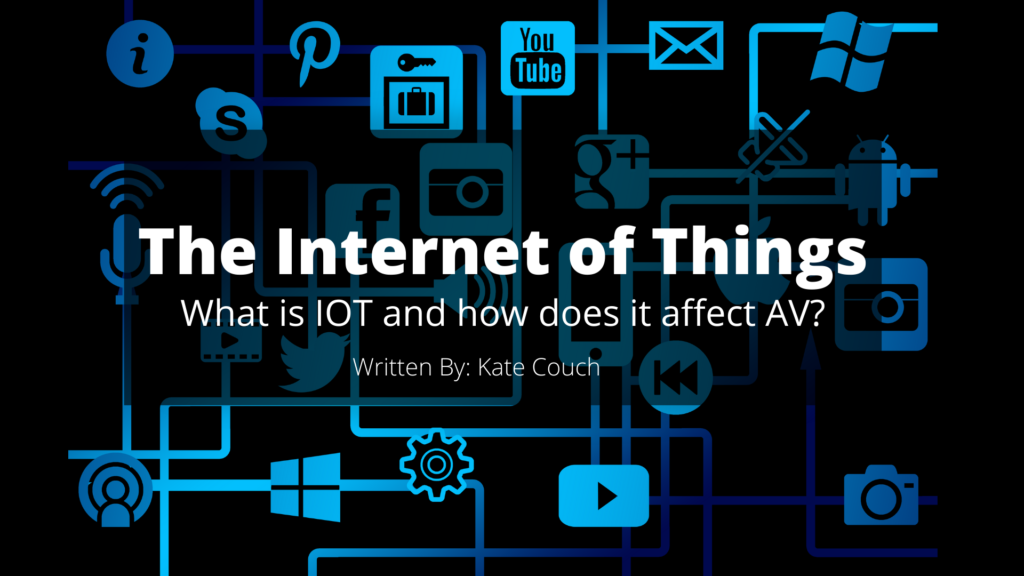
Photo and graphics created by Kate Couch with Canva
What is the IOT and how will it affect AV?
Earlier this month we mentioned how we would be going into depth about the Internet of Things. What is the Internet of Things? Simply put the Internet of Things is: device, connection, and data collection. It also is the number of devices connected to the internet. With everything from scales, TVs to your refrigerator “everything” nowadays is a smart device, meaning that it has the ability to be connected to the internet. The idea that everything will soon become connected to the internet or how many things are connected to the internet is called The Internet of Things or IOT.
Currently, there are 27.6 billion gadgets connected to the internet according to multiple sources. People also predict that by the end of 2021 there will be 46 billion devices connected to the internet. These numbers are insane And according to an article done by Sloan in 2018, there were 17 billion devices connected to the internet so in three years an roughly additional 10 billion Devices were created to be able to connect to the internet.
Audio-visual has a huge play in IOT mostly because audio-visual falls under a lot of the categories of these gadgets. Microphones, sound systems, TVs, projectors, smart audio, and lighting equipment, all of these things are now connected to the internet. Earlier in an AV career, a considerable amount of these things would not be connected to the internet. There was no need for your projector to connect to the internet, it connected to your computer which connected to the internet. There is no need for your light bulb to connect to the internet or your microphone but now all these things do and it heavily affects how we do things in our industry.
A huge part of IOT is data collection. The idea of data collection scares a lot of people. It goes back to the age-old belief that the government is wiretapping your homes and now for most people that is in-home assistant devices like Alexa. There is no proof for this theory that the government is listening to your conversations even when you do not interact with your home device. However, there is still data collection behind those things. In a corporate office, this can be extremely useful for a multitude of reasons.
The nice thing about data is it’s universal so even though it’s only collecting one type of data it can apply to many different areas. If you want to cut your electric bill cost down you can look at the data your smart devices have collected to see where you’re wasting electricity. If you want a performance scan on your projectors or your audio equipment you no longer have to have people come out and tell you that your equipment is outdated or have them troubleshoot. A lot of times now the beginning steps of troubleshooting can be done from your phone. Many of the smart things we see in our homes will soon be incorporated into the corporate office.
We talked about this on our blog a couple of weeks ago. The idea of having a smart home can look much like having a smart office. The ability to control lighting, sound, what doors are locked, who’s in who’s room, all from the small device that fits in your back pocket.
This data collection in addition to being used for clients of AV homes and offices can also be used for audiovisual team members themselves. Through this constant data collection, you can see how your customer’s equipment is performing or understand the needs of your client better through data collection of other smart devices in their home. The options of data collection through IOT are endless and it’s honestly the most astounding part. Even though it’s cool that all of your devices can be connected to the internet the part that really stands out, unlike any other time in history is the data collection. This is the first time in human history that we can collect and retrieve data so fast. To instantly get the analytics on any device we have almost no matter what it’s used for… it’s revolutionary.
IOT is a large subject that we will be going more in-depth within later weeks. But the takeaway today is that the Internet of Things is a vast, interconnected world that doesn’t just affect AV it affects nearly every industry, in every aspect of life that involves a device.
*This article is Tony Sprando of AV Bends intellectual property. To use or reference this article please contact: Tony@avbend.com*
To know more about Tony and his professional profile see these:
To know more about Kate and her professional profile see these:
April 13th, 2021
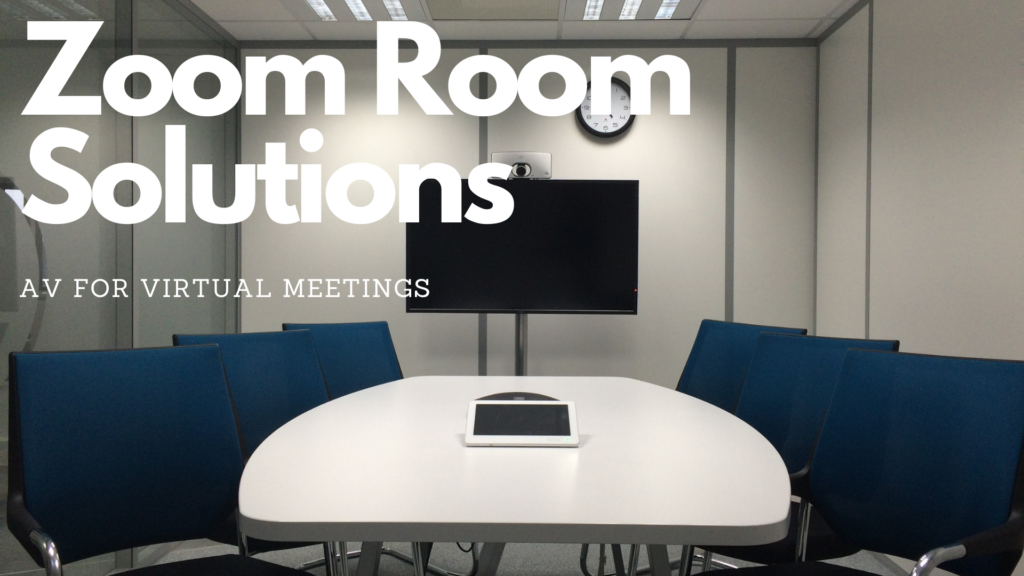
Graphic Design by, Kate Couch Photo by, Canva
Finding the right equipment for your virtual meetings.
(Click on the title to see linked websites)
Written By: Kate Couch and Tony Sprando
Many companies are now using the application Zoom for virtual meetings. This solves a lot of problems and even post-pandemic will probably be used on a regular basis. Virtual meetings are extremely efficient and helpful for traveling or non-local employees. However, getting the proper set up so you can have efficient meetings is crucial. Gathered below is a list of video and audio equipment made specifically with virtual meetings in mind. Maybe you’ll find one that’ll be just right for your company. Most of these Products do require AV installation. Make sure to reach out to a local AV company ( like AV Bend!) to find the right products and set-up for you.
The Meeting Owl Pro is a 360-degree camera, mic, and speaker device for meetings. You would set this device on the center of the meeting table and when someone was to talk the camera would spin and face that person. There are multiple cameras inside of the head so the spin would not be drastic. Is described as an extremely immersive experience making meetings easy to have and there is no need to crowd together in front of a single angle camera. It can connect with their other technology that makes meetings easier known as their meeting headquarters which is a tablet that connects to other products and a host be the Hub of the meeting. It is ideal for large room meetings with lots of members and people who want something that is easy and efficient. It comes with a two-year warranty and a 30-day money-back guarantee.
Logitech teamed up with Zoom to create what they coined is Zoom room Solutions which is a bunch of products specifically designed to help with Zoom meetings. They have packages that are called Zoom room packages that come with cameras, microphones, and host hub tablets. They have way more information on their website but it can go from something as simple as a camera as a one angled camera microphone duo that can sit on a desk all the way up to multiple cameras in a full set up if you choose to go with something like that you may be better off having an audiovisual company install it for you. They have over a dozen products for you to find the right one for your company. Logitech Zoom room solutions are best for people who need a wide range of options and to use Microsoft and PC software.
Price: Require individual quotes
An IP-based platform for AV control, plus room scheduling and AV asset management. It does not have a microphone or camera setup, however, it is a great way to control a Zoom room that already has an audio-visual technology plan integrated into the room. It is also good for any other technology you want to connect with. This is a bit more intricate of a system and would require an audio-visual company to set it up and get it started in your workspace. If you plan on using Zoom or other audio-visual technology-based programs long-term this is a good option for you.
Legrand has a very large selection of high-quality cameras used for all over a room. From the ceiling to the walls, on tables, and in other areas, they have a camera that will fit. They have something that not a lot of other companies have, ceiling microphones. Ceiling microphones are super convenient for people who need a lot of table space and want something that is aesthetically pleasing and out of the way. Legrand Has some of the most high-tech setups and product options but do you require a lot of planning and an AV team to set up. If you want something that you plan to be semi-permanent, sleek, and high-quality Legrand is the company for you.
Extron is a camera mic combo that comes with a control tablet similar to other companies. It is good for small to medium-sized companies that don’t have people that don’t have more than five or six people in a meeting at a time. They have excellent audio quality and aren’t as simple as the Owl Labs, but not as high-tech as some of the others. It would require some professional AV set-up, but very minimal compared to what other products need. It’s also a good option for Apple users as they cater to that specifically in addition to Microsoft/PC. If you’ve got a small space with, limited budget but still want something that has high quality this is a good option for you.
The Crestron Workspace solutions UC-B30-T is a camera microphone combo with a control panel and built-in wall mount for the system and TV/ Monitor. This is one of the spender solutions on the list, however, it’s an extremely easy process to set it up and the materials are high-quality. It’s ideal for meetings under 10 people who don’t need a lot of fancy camera angles or microphone setup. If you have a company that’s fast-paced and wants a solution that’s going to be, quick, efficient, and still have excellent quality this is a great solution for you. Unfortunately, they only cater to Microsoft users.
Stem audio has some of the sweetest microphone and speaker solutions on the market today. Using Shure audio combined with the designs needed for virtual meetings they created 5 products for users to choose from. If you already have a good camera setup or are doing virtual meetings via Audio Only stem audio is definitely something to consider. They’re on the cheaper end for such high-quality audio equipment.
The pricing of the solutions that we listed also varies based on how easy or difficult they are to install. Once you get an idea of a couple you might be interested in it’s best to reach out to your local AV company (like AV Bend!) to see how much it is going to cost you to solve the specific problems that you have with virtual meetings. Luckily over the last year, a lot has been designed and put out on the market so whether you have a budget over $1,000 or under $1,000 there’s going to be something that will work for you.
To know more about Tony and his professional profile see these:
To know more about Kate and her professional profile see these:
April 6th, 2021
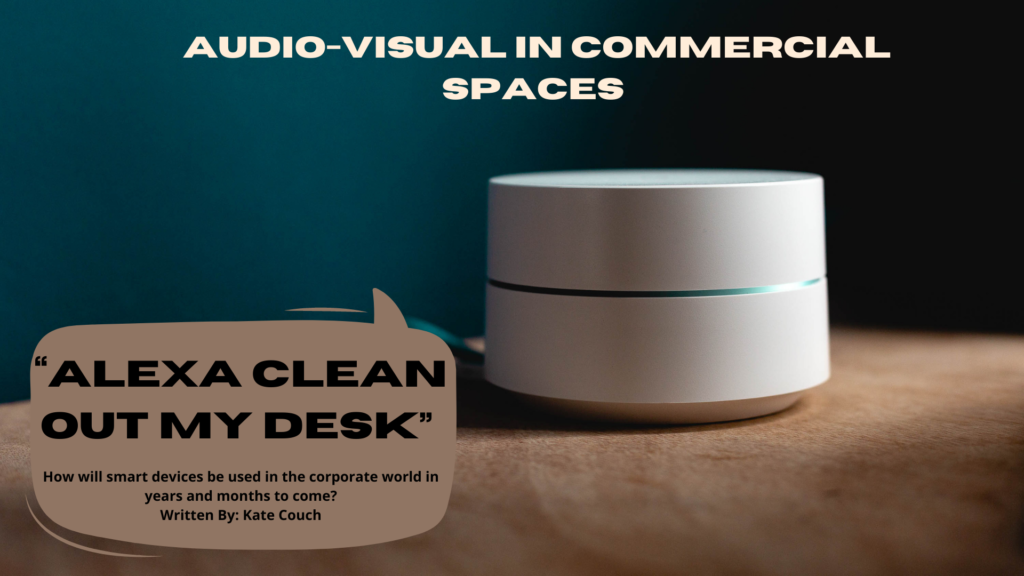
Image and graphic design by, Kate Couch and Canva
How will smart devices be used in the corporate world in years and months to come?
Last year the corporate office took a large turn as many of us had to begin working remotely from home. This created an entirely new world for audiovisual- Zoom. Zoom as most companies are aware is an online video conferencing platform that is for personal, educational, and corporate use. Since this is now one of the primary ways that offices and businesses have meetings a lot of them have been needing a dedicated space or what we at Audio-Visual Bend call a zoom-room. These zoom-rooms have become very popular over the last year and many corporate offices have incorporated them into the workspace. It can look like only an audio-visual setup or accompanied by complete acoustical treatment. But with this drastically new technology becoming popular so quickly it poses the question, what other highly technological things will be introduced into the corporate world in the upcoming months and years?
The statements, “Alexa schedule my meetings for next week” or “hey Google what conference room is open?” Might sound a little outlandish, they’re actually both current technology used in the corporate world. Starting in 2018 Amazon launched Alexa for business which is an Alexa platform designed for more business-type use, scheduling meetings, general questions around the office, dimming lights, etc. It’s a very unique idea that something we use in our homes could also be so useful in the office. These AI personal assistants are now available to anyone no matter their title of job. With Alexa for business, Alexa can communicate with the Amazon Echo devices (full-size, dot, or other) assigned to each room and answer you with something like, “The conference room near the IT deck is empty.” You can also say things like, “Alexa, book me a conference room” with the time and date. You can also schedule it out further or see if any are available right away.
This new tech is extremely efficient but also goes to show how much audio-visual will be part of almost every corporate business in years to come. Virtual conference rooms, acoustical treatment plans, high-tech phone systems, Wi-Fi, and possibly even Echo and Alexa setup and design could all be things that are more common in years to come. It currently hasn’t caught on as well as it probably will in the next year, In Unit4’s 2017 Enterprise Tech End-User Sentiment Survey, they found that 38% of professionals affirmed that they use a digital assistant like Alexa for personal reasons; only 11% use it in their professional lives. They asked that 38% if they would trust a digital assistant like Alexa for a work-related task, 54% thought they would. This shows the interest is there and it will just take time for it to trickling into our offices and workspaces.
Because of what has happened in the past year all corporate offices have been forced to rise to the level of tech. Unfortunately, we will see a lot of small businesses fall behind because they can’t keep up with it. The idea that everything is going to be high-tech and connected to Wi-Fi is called The Internet of Things or IOT. On our blog, we will be doing more articles in the weeks to come on this topic. The internet of things is going to affect the corporate world and a very large way and it’s going to affect Audio Visual in even a larger way; as we both have to incorporate it into our offices but also be able to incorporate it into others as our clients. So follow along if you want to know more about IOT and high-tech things that audiovisual will be incorporating and general corporate offices will be incorporating in the future.
To know more about Tony and his professional profile see these:
To know more about Kate and her professional profile see these:










